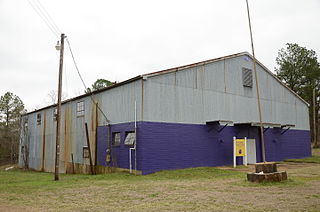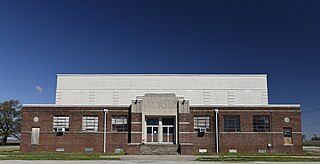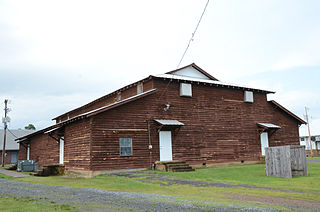
Philander Smith College is a private historically black college, in Little Rock, Arkansas. Philander Smith College is affiliated with the United Methodist Church and is a founding member of the United Negro College Fund (UNCF). Philander Smith College is accredited by the North Central Association of Colleges and Schools.

Cotter High School (CHS) is a comprehensive public junior-senior high school for students in grades 7 through 12 located in Cotter, Arkansas, United States. It is the sole high school of Cotter School District. The teacher-student ratio is approximately 10:1. Cotter High School serves the cities of Cotter and Gassville.

The University of Arkansas Campus Historic District is a historic district that was listed on the National Register of Historic Places on September 23, 2009. The district covers the historic core of the University of Arkansas campus, including 25 buildings.

Old Greenwood High School is a historic high school building located at Greenwood, Greenwood County, South Carolina. It was designed by the firm of Wilson, Berryman & Kennedy and built in 1925–1926. It is a complex of three brick buildings – the main building, the auditorium, and the gymnasium – each of which is in the Georgian Revival style and form a Palladian configuration. Each of the three buildings features a portico supported by six Tuscan order columns. The complex was completed with construction of the gymnasium building in 1929–1930.

The Okolona Colored High School Gymnasium is a historic academic athletic building at 767 Layne Street in Okolona, Arkansas. It is the only surviving building of a school campus built c. 1950 to provide schooling to local African-American students. The building is a large rectangular structure with no significant stylistic elements. Its walls are primarily corrugated metal, although a portion of the front and sides near the front are composed of clay tile blocks. The campus it was a part of began in 1928 with a modest two-room school building constructed with supported from the Rosenwald Fund, and grew over the years to include vocational and home economics facilities, in addition to a cafeteria and additional classrooms. The gymnasium was designed to serve as a multi-function athletic facility and meeting space for the local African-American community. The Okolona schools were consolidated with those of neighboring Simmons, and all of the other buildings of this campus were demolished in the 1970s and 1980s.

The Clover Bend High School is a historic community building on Arkansas Highway 228 in Clover Bend, Arkansas. It is a single-story wood-frame structure, with a main central hip-roofed block, symmetrical side wings with gable roofs, and a rear projecting auditorium section. It was built in 1937–38 with funding from the Farm Security Administration, with a number of additional buildings added to the complex in later years, including a gymnasium, elementary school, and administrator housing. This complex formed the core of a major rural resettlement project, which included more than 90 farms.

The Big Flat School Gymnasium is a historic school building in Big Flat, Arkansas. It is a single-story stone masonry structure with a gable roof. It is basically Plain-Traditional in its styling, except for its Craftsman-style entrance porches, both located on the south (main) facade. The most significant alteration since its construction in 1938-41 is the replacement of the eastern stone wall with a frame structure clad in artificial siding. The gymnasium was built by crews of the National Youth Administration, and is the only major public works building in the community.

The Horace Mann School Historic District of Norfork, Arkansas encompasses a complex of four Depression-era school buildings near the center of the community. It includes a main school building, built with Works Progress Administration (WPA) funding in 1936, a home economics building and a vocational educational building, both built in 1937 by the National Youth Administration, and the auditorium/gymnasium, built in 1940 with WPA funds. All are single-story Craftsman-style buildings, although the gymnasium presents more stories because of a partially exposed basement. The complex was used as a school until the mid-1980s, and is now owned by the city, which uses the buildings for a variety of purposes. It is a well-preserved and remarkably complete Depression-era school complex.

Aggie Hall is a historic former gymnasium in Bruno, Arkansas, a short way south of Arkansas Highway 235. It is a single-story stone structure, topped by a hip roof which has a clerestory section at its center. The clerestory is finished in weatherboard; both roof lines have Craftsman-style exposed rafter ends. The building was erected in 1926 by the student members of the Lincoln Aggie Club, believed to be the first chapter established of the Future Farmers of America, and was originally intended as a gymnasium for the adjacent Bruno School and as a location for the club's activities.

The Berryville Gymnasium is a historic school building, located in a large school complex on the west side of Berryville, Arkansas. It is a single-story stone masonry structure, with a gable-on-hip roof. It is taller to accommodate the height of the gymnasium within, and has a second row of windows across some facades to provide added illumination into that facility. The building was constructed in 1936–37 with funding assistance from the Works Progress Administration.

The Bruno School Building was a historic school building a short way south of Arkansas Highway 9 in Bruno, Arkansas. It was a single story Plain Traditional (vernacular) frame structure, with a gable roof and a front porch with gabled pediment. Built in 1920, it had some Craftsman style influence, including exposed rafter tails and the square columns on stone piers which supported the porch. It was a locally significant well-preserved example of a rural school building.

The Camp Crowder Gymnasium is a historic school building at 205 Shiloh Drive in Sulphur Springs, Benton County, Arkansas. It is a tall single-story wood frame structure, covered in weatherboard, with normal-height single-story shed-roofed sections running the length of the building. It was built in the early 1940s at Camp Crowder, a military base in Missouri, and moved to this location in 1948 by the Brown Military Academy of the Ozarks. The complex which it is a part of has gone through a variety of institutional ownership changes, with the building continuing to serve as a focus of recreational activities. It is a rare example of military construction in the small community.

The Sulphur Springs Old School Complex Historic District encompasses a collection of connected school buildings at 512 Black Street in Sulphur Springs, Benton County, Arkansas. The main school building is a somewhat vernacular single-story brick structure with a gable-on-hip roof, built in 1941 with funding from the Works Progress Administration. Its main entrance is set in a tall arched opening decorated with buff brick. It is connected via covered walk to the gymnasium, a craftsman-style wood frame structure with a gable-on-hip roof and novelty siding. The gym was built in 1925 as a military barracks at Camp Crowder in Neosho, Missouri, and was moved to this location in 1948. A wood-frame hyphen connects the gym to the 1949 cafeteria, a vernacular brick building. The school complex was used until 1965 when Sulphur Springs' school were consolidated with those of Gravette. The school now houses the local police department, history museum, and community meeting spaces.

The Wilson High School Gymnasium is a historic school athletic facility at Main and Lee Streets in Wilson, Arkansas. Built in 1948 and used until 1965, this large single-story Art Deco brick building is a remarkably well-preserved facility, with original floors, bleachers, and equipment such as basketball hoops and scoreboards. The pool at the rear of the building retains original tile work.

The Carver Gymnasium is a historic school building at 400 Ferguson Street in Lonoke, Arkansas. It is a vernacular single-story structure, built out of concrete blocks and capped by a gabled metal roof. The gable ends are clad in metal siding, and there are irregularly spaced awning windows on the walls. It was built in 1957 for the Carver School, the segregated facility serving Lonoke's African-American students, and is its last surviving building. After the city's schools were integrated in 1970, the school complex served as its junior high school, and was vacated by the school system in 2005.

The Guy High School Gymnasium is a historic school building on the campus of the Guy-Perkins District School System on Arkansas Highway 25, just east of Guy, Arkansas. It is a single story stone structure, with a gabled rood and four brick chimneys. Two gabled porches project from the front side, near the corners, each supported by stone columns and featuring stuccoed pediments. It was built by local labor with funding support from the Works Progress Administration in 1938.

The Guy Home Economics Building is a historic school building on the campus of the Guy-Perkins School District, east of Guy, Arkansas. It is a single story stone structure, with a gabled roof that features exposed rafter ends and large Craftsman brackets at the gable ends. A single-story gabled porch, with an arched opening, shelters the main entrance. It was built in 1936 with funding support from the Works Progress Administration.

The Damascus Gymnasium is a historic school building on Arkansas Highway 285 in Damascus, Arkansas. It is a rustic 1-1/2 story wood frame structure, with a central clerestory section covered by a gable-on-hip roof, and side wings covered by a shed roof. The main entrance, on the east side, is sheltered by a gabled porch, with secondary entrances on the south side, each sheltered by a gable roof supported by large brackets. The gymnasium was built in 1933 with funding support from the Works Progress Administration.

The Menifee High School Gymnasium is a historic school building at North Park and East Mustang Streets in Menifee, Arkansas. It is a single-story frame structure, its exterior finished in uncoursed fieldstone veneer. It has a gabled roof with exposed rafter ends, and two entry pavilions with gable roofs supported by stone posts. It was built in 1938 with funding support from the Works Progress Administration, and was one of the first three WPA-funded athletic facilities built specifically for a segregated African-American school.

The Lockesburg High School Gymnasium is a historic school gymnasium at 128 East Main Street in Lockesburg, Arkansas. Built in 1952–53, it is a utilitarian rectangular building, built out of concrete blocks and resting on a poured concrete foundation. Its main facade is the north side, with a center entrance shaded by an awning, and symmetrically placed porthole windows on either side. Most of the building's interior is taken up by the actual playing area, with tiered bleachers on two sides. The interior finishes are largely original materials. It was built to meet growing post-World War II demand for improved school facilities, and has historically served as a venue for most of the community's larger-scale social events. The school closed in 1968; the building is now owned by Cossatot Community College.



















